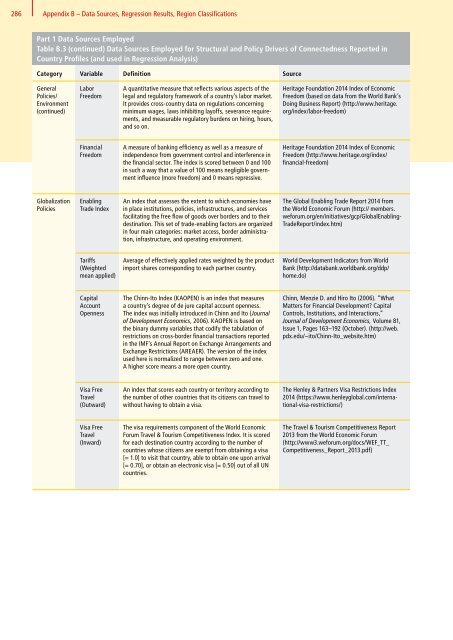DHL Global Connectedness Index 2014
DHL Global Connectedness Index 2014
DHL Global Connectedness Index 2014
- No tags were found...
You also want an ePaper? Increase the reach of your titles
YUMPU automatically turns print PDFs into web optimized ePapers that Google loves.
286 Appendix B – Data Sources, Regression Results, Region Classifications<br />
Part 1 Data Sources Employed<br />
Table B.3 Data (continued) Sources Data Employed Sources for Employed Structural for and Structural Policy Drivers and Policy of <strong>Connectedness</strong> Drivers of <strong>Connectedness</strong> Reported in Reported Country Profiles in<br />
Country (and used Profiles in Regression (and used Analysis) in Regression Analysis)<br />
Category Variable Definition Source<br />
General<br />
Policies/<br />
Environment<br />
(continued)<br />
Labor<br />
Freedom<br />
A quantitative measure that reflects various aspects of the<br />
legal and regulatory framework of a country’s labor market.<br />
It provides cross-country data on regulations concerning<br />
minimum wages, laws inhibiting layoffs, severance requirements,<br />
and measurable regulatory burdens on hiring, hours,<br />
and so on.<br />
Heritage Foundation <strong>2014</strong> <strong>Index</strong> of Economic<br />
Freedom (based on data from the World Bank’s<br />
Doing Business Report) (http://www.heritage.<br />
org/index/labor-freedom)<br />
Financial<br />
Freedom<br />
A measure of banking efficiency as well as a measure of<br />
independence from government control and interference in<br />
the financial sector. The index is scored between 0 and 100<br />
in such a way that a value of 100 means negligible government<br />
influence (more freedom) and 0 means repressive.<br />
Heritage Foundation <strong>2014</strong> <strong>Index</strong> of Economic<br />
Freedom (http://www.heritage.org/index/<br />
financial-freedom)<br />
<strong>Global</strong>ization<br />
Policies<br />
Enabling<br />
Trade <strong>Index</strong><br />
An index that assesses the extent to which economies have<br />
in place institutions, policies, infrastructures, and services<br />
facilitating the free flow of goods over borders and to their<br />
destination. This set of trade-enabling factors are organized<br />
in four main categories: market access, border administration,<br />
infrastructure, and operating environment.<br />
The <strong>Global</strong> Enabling Trade Report <strong>2014</strong> from<br />
the World Economic Forum (http:// members.<br />
weforum.org/en/initiatives/gcp/<strong>Global</strong>Enabling-<br />
TradeReport/index.htm)<br />
Tariffs<br />
(Weighted<br />
mean applied)<br />
Average of effectively applied rates weighted by the product<br />
import shares corresponding to each partner country.<br />
World Development Indicators from World<br />
Bank (http://databank.worldbank.org/ddp/<br />
home.do)<br />
Capital<br />
Account<br />
Openness<br />
The Chinn-Ito <strong>Index</strong> (KAOPEN) is an index that measures<br />
a country’s degree of de jure capital account openness.<br />
The index was initially introduced in Chinn and Ito (Journal<br />
of Development Economics, 2006). KAOPEN is based on<br />
the binary dummy variables that codify the tabulation of<br />
restrictions on cross-border financial transactions reported<br />
in the IMF’s Annual Report on Exchange Arrangements and<br />
Exchange Restrictions (AREAER). The version of the index<br />
used here is normalized to range between zero and one.<br />
A higher score means a more open country.<br />
Chinn, Menzie D. and Hiro Ito (2006). “What<br />
Matters for Financial Development Capital<br />
Controls, Institutions, and Interactions,”<br />
Journal of Development Economics, Volume 81,<br />
Issue 1, Pages 163–192 (October). (http://web.<br />
pdx.edu/~ito/Chinn-Ito_website.htm)<br />
Visa Free<br />
Travel<br />
(Outward)<br />
An index that scores each country or territory according to<br />
the number of other countries that its citizens can travel to<br />
without having to obtain a visa.<br />
The Henley & Partners Visa Restrictions <strong>Index</strong><br />
<strong>2014</strong> (https://www.henleyglobal.com/international-visa-restrictions/)<br />
Visa Free<br />
Travel<br />
(Inward)<br />
The visa requirements component of the World Economic<br />
Forum Travel & Tourism Competitiveness <strong>Index</strong>. It is scored<br />
for each destination country according to the number of<br />
countries whose citizens are exempt from obtaining a visa<br />
[= 1.0] to visit that country, able to obtain one upon arrival<br />
[= 0.70], or obtain an electronic visa [= 0.50] out of all UN<br />
countries.<br />
The Travel & Tourism Competitiveness Report<br />
2013 from the World Economic Forum<br />
(http://www3.weforum.org/docs/WEF_TT_<br />
Competitiveness_Report_2013.pdf)





